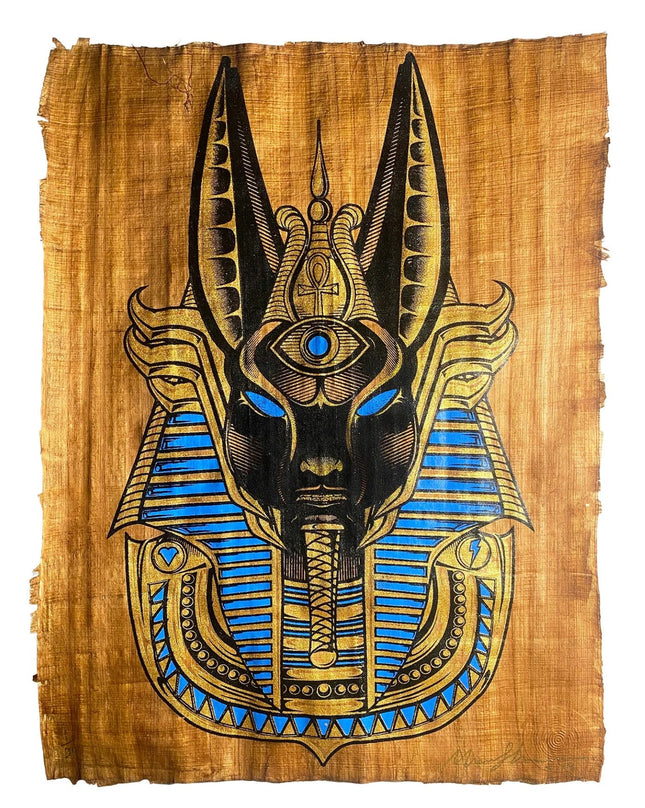
Religion
-

Marwan Shahin Anubis Afterlife Silkscreen Print by Marwan Shahin
Anubis Afterlife 4-Color Hand-Pulled Diamond Dust Limited Edition Silkscreen Print on Egyptian Papyrus Paper by Marwan Shahin Street Art Pop Artwork Artist. 2022 Signed & Numbered Limited Edition of 30 Size 14x17.5 "Shahin Studios is delighted to present ANUBIS AFTERLIFE by Marwan Shahin; this is the conclusion of months of experimenting with different stains to age the Papyrus paper. The new edition of the artwork is interpreted with hand-pulled four color Silkscreen print on Soy-Stained Authentic Egyptian Papyrus, and each print intricately arranged with a lattice of black Diamond Dust, to produce visually intoxicating kaleidoscope-like effects." -Marwan Shahin. The Creative Odyssey of Marwan Shahin's "Anubis Afterlife" "Anubis Afterlife," a mesmerizing creation by Marwan Shahin, represents a striking convergence of ancient tradition and contemporary artistic practice. As a street pop artwork, this limited edition silkscreen print on Egyptian papyrus paper encapsulates the spirit of modern pop art while paying homage to the rich iconography of ancient Egypt. The use of authentic papyrus as a medium is a salute to the time-honored methods of artistic expression, further enhanced by Shahin’s innovative aging techniques that lend the work an air of antiquity. Artistic Alchemy on Papyrus Shahin, an Egyptian street art pop artwork artist, embarked on a meticulous process of experimentation to perfect the aging of the papyrus, aiming to achieve a soy-stain effect that imbues the paper with an ethereal quality reminiscent of historical artifacts. The artwork, a limited edition of 30 and 14x17.5 inches, features the god Anubis, the ancient Egyptian deity associated with mummification and the afterlife. This figure is intricately detailed with four hand-pulled silkscreen layers, culminating in a visually arresting and richly symbolic composition. The incorporation of black diamond dust in the artwork adds a tactile dimension that catches the light, creating kaleidoscopic effects that enhance the mystical aura of the piece. Diamond dust, a material once popularized by Andy Warhol, reflects Shahin's ingenuity in combining traditional screen-printing techniques with the luxurious embellishments in pop art. The resulting work is an homage to Shahin's homeland's cultural heritage, street art's vibrant energy, and the glossy sheen of pop art. Marwan Shahin's Visual Fusion of Past and Present "Anubis Afterlife" is a testament to Marwan Shahin's creative vision, where Egyptian art's rich legacy intersects with street pop art's bold immediacy. Through the figure of Anubis, Shahin bridges millennia, conversing with the symbols of ancient mythology while engaging with the aesthetics of the present. The choice of Anubis, a deity symbolizing the passage to the afterlife, suggests exploring themes such as transition, transformation, and the eternal cycle of life and death. This piece's introduction of street pop art into the pantheon of Egyptian motifs presents a unique narrative layer. In much the same way street art often appropriates and recontextualizes images and symbols from mainstream culture, Shahin reclaims an icon from his cultural history, reinterpreting it through a modern lens. This reimagining places "Anubis Afterlife" within the lineage of pop art that challenges and redefines the boundaries between high and low culture. A Tapestry of Time Woven by Marwan Shahin Marwan Shahin's "Anubis Afterlife" is a luminous example of how contemporary artists can delve into the wellspring of their heritage while contributing to the global convert conversation, underscores the potential of street pop art and graffiti to serve as a platform for cultural storytelling and artistic innovation. Through his fusion of mediums and motifs, Shahin crafts a visual tapestry that spans the ancient and the avant-garde, inviting onlookers to contemplate the seamless continuity between history and modernity. In pop art and street art, Shahin's work exemplifies how traditional elements can be re-envisioned to resonate with new audiences. His intricate layering of colors and materials transcends mere reproduction, offering an immersive experience that reflects the past and is a beacon for the future of artistic expression. "Anubis Afterlife," with its textured narrative and visual splendor, is a fine art collectible and a piece that captures the dynamic spirit of street art, embodying the pulse of a culture that reverberates through time.
$771.00


